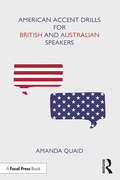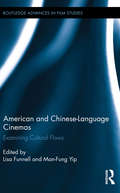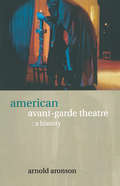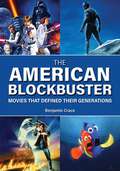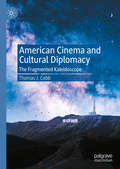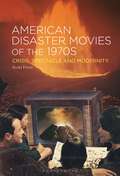- Table View
- List View
American Accent Drills for British and Australian Speakers
by Amanda QuaidAmerican Accent Drills for British and Australian Speakers provides a comprehensive guide to learning a "General American" accent, made specifically for native English speakers. Unlike most American accent guides, which are geared toward ESL learners, this handbook covers only the shifts that English speakers need to make – nothing more, nothing less. In addition to vowel and consonant drills, it covers the finer points of American intonation and elision, features that often elude English speakers of other dialects. Finally, it provides exercises for "owning" the dialect, finding authenticity and making it work for each individual actor in their own way. This is an excellent resource for students of speech and dialects, actors from the UK, Australia, and New Zealand, and advanced ESL learners who need to use an American accent on screen or on stage. American Accent Drills for British and Australian Speakers also includes access to downloadable audio files of the practice drills featured in the book, to help students practice and perfect their American accent.
American and Chinese-Language Cinemas: Examining Cultural Flows (Routledge Advances in Film Studies)
by Lisa Funnell Man-Fung YipCritics frequently describe the influence of "America," through Hollywood and other cultural industries, as a form of cultural imperialism. This unidirectional model of interaction does not address, however, the counter-flows of Chinese-language films into the American film market or the influence of Chinese filmmakers, film stars, and aesthetics in Hollywood. The aim of this collection is to (re)consider the complex dynamics of transnational cultural flows between American and Chinese-language film industries. The goal is to bring a more historical perspective to the subject, focusing as much on the Hollywood influence on early Shanghai or postwar Hong Kong films as on the intensifying flows between American and Chinese-language cinemas in recent decades. Contributors emphasize the processes of appropriation and reception involved in transnational cultural practices, examining film production, distribution, and reception.
American and Chinese-Language Cinemas: Examining Cultural Flows (Routledge Advances in Film Studies)
by Lisa Funnell Man-Fung YipCritics frequently describe the influence of "America," through Hollywood and other cultural industries, as a form of cultural imperialism. This unidirectional model of interaction does not address, however, the counter-flows of Chinese-language films into the American film market or the influence of Chinese filmmakers, film stars, and aesthetics in Hollywood. The aim of this collection is to (re)consider the complex dynamics of transnational cultural flows between American and Chinese-language film industries. The goal is to bring a more historical perspective to the subject, focusing as much on the Hollywood influence on early Shanghai or postwar Hong Kong films as on the intensifying flows between American and Chinese-language cinemas in recent decades. Contributors emphasize the processes of appropriation and reception involved in transnational cultural practices, examining film production, distribution, and reception.
AMERICAN AVANT-GARDE C
by Rebecca A. SheehanCan films philosophize rather than simply represent philosophical ideas developed outside of the cinematic medium? Taking up this crucial question for the emergent field of film philosophy, American Avant-Garde Cinema's Philosophy of the In-Between argues that the films of the American avant-garde do in fact do philosophy and illuminates the ethical stakes of their aesthetic interventions. Author Rebecca A. Sheehan contends that American avant-garde cinema's characteristic self-reflexivity is an interrogation of the modes and stakes of our engagement with the world on and beyond the screen. The book demonstrates this with the theory of the in-between: a pervasive figure that helps clarify how avant-garde cinema's reflections on the creation of images construct an ethics of perception itself, a responsibility to perpetuate thought in an enduring re-encounter with the world and with meaning's unfinished production. The book is structured by a taxonomy of the multiple in-betweens evident in American avant-garde filmmaking. Rather than systematically seeking reproductions of particular philosophers' ideas in avant-garde films, Sheehan derives categories of analysis and the philosophical claims they disclose from close readings of the films themselves. This methodology opposes mapping preconfigured philosophical concepts and values onto these films, as too many philosophical approaches to cinema have done, silencing the philosophies uniquely articulated by these films in the interest of making them ventriloquize philosophies advanced elsewhere. The chapters of this book trace three modes of the in-between that function philosophically in American avant-garde cinema: the material, the dimensional, and the conceptual. Although the chapters are organized around discrete aesthetic and philosophical preoccupations that unify several filmmakers, these three presentations of the in-between cut through all the chapters, allowing the subjects of each to converse over the course of the book.
American Avant-Garde Cinema's Philosophy of the In-Between
by Rebecca A. SheehanCan films philosophize rather than simply represent philosophical ideas developed outside of the cinematic medium? Taking up this crucial question for the emergent field of film philosophy, American Avant-Garde Cinema's Philosophy of the In-Between argues that the films of the American avant-garde do in fact do philosophy and illuminates the ethical stakes of their aesthetic interventions. Author Rebecca A. Sheehan contends that American avant-garde cinema's characteristic self-reflexivity is an interrogation of the modes and stakes of our engagement with the world on and beyond the screen. The book demonstrates this with the theory of the in-between: a pervasive figure that helps clarify how avant-garde cinema's reflections on the creation of images construct an ethics of perception itself, a responsibility to perpetuate thought in an enduring re-encounter with the world and with meaning's unfinished production. The book is structured by a taxonomy of the multiple in-betweens evident in American avant-garde filmmaking. Rather than systematically seeking reproductions of particular philosophers' ideas in avant-garde films, Sheehan derives categories of analysis and the philosophical claims they disclose from close readings of the films themselves. This methodology opposes mapping preconfigured philosophical concepts and values onto these films, as too many philosophical approaches to cinema have done, silencing the philosophies uniquely articulated by these films in the interest of making them ventriloquize philosophies advanced elsewhere. The chapters of this book trace three modes of the in-between that function philosophically in American avant-garde cinema: the material, the dimensional, and the conceptual. Although the chapters are organized around discrete aesthetic and philosophical preoccupations that unify several filmmakers, these three presentations of the in-between cut through all the chapters, allowing the subjects of each to converse over the course of the book.
American Avant-Garde Theatre: A History (Theatre Production Studies)
by Arnold AronsonThis stunning contribution to the field of theatre history is the first in-depth look at avant-garde theatre in the United States from the early 1950s to the 1990s. American Avant-Garde Theatre offers a definition of the avant-garde, and looks at its origins and theoretical foundations by examining: *Gertrude Stein *John Cage *The Beat writers *Avant-garde cinema *Abstract Expressionism *Minimalism There are fascinating discussions and illustrations of the productions of the Living Theatre, the Wooster Group, Open Theatre, Ontological-Hysteric Theatre and Performance Group. among many others. Aronson also examines why avant-garde theatre declined and virtually disappeared at the end of the twentieth century.
American Avant-Garde Theatre: A History (Theatre Production Studies)
by Arnold AronsonThis stunning contribution to the field of theatre history is the first in-depth look at avant-garde theatre in the United States from the early 1950s to the 1990s. American Avant-Garde Theatre offers a definition of the avant-garde, and looks at its origins and theoretical foundations by examining: *Gertrude Stein *John Cage *The Beat writers *Avant-garde cinema *Abstract Expressionism *Minimalism There are fascinating discussions and illustrations of the productions of the Living Theatre, the Wooster Group, Open Theatre, Ontological-Hysteric Theatre and Performance Group. among many others. Aronson also examines why avant-garde theatre declined and virtually disappeared at the end of the twentieth century.
The American Blockbuster: Movies That Defined Their Generations
by Benjamin CraceProviding an indispensable resource for students and general readers, this book serves as an entry point for a conversation on America's favorite pastime, focusing in on generational differences and the evolution of American identity.In an age marked by tension and division, Americans of all ages and backgrounds have turned to film to escape the pressures of everyday life. Yet, beyond escapism, popular cinema is both a mirror and microscope for our collective psyche. Examining the films that have made billions of dollars through a new lens reveals that popular culture is a vital source for understanding what it means to be an American.This book is divided into four sections, each associated with a different generation. Featuring such era-defining hits as Jaws, Back to the Future, Avatar, and The Avengers, each section presents detailed film analyses that showcase the consistency of certain American values throughout generations as well as the constant renegotiation of others. Ideal for any cinephile, The American Blockbuster demonstrates how complex and meaningful even the summer blockbuster can be.
The American Blockbuster: Movies That Defined Their Generations
by Benjamin CraceProviding an indispensable resource for students and general readers, this book serves as an entry point for a conversation on America's favorite pastime, focusing in on generational differences and the evolution of American identity.In an age marked by tension and division, Americans of all ages and backgrounds have turned to film to escape the pressures of everyday life. Yet, beyond escapism, popular cinema is both a mirror and microscope for our collective psyche. Examining the films that have made billions of dollars through a new lens reveals that popular culture is a vital source for understanding what it means to be an American.This book is divided into four sections, each associated with a different generation. Featuring such era-defining hits as Jaws, Back to the Future, Avatar, and The Avengers, each section presents detailed film analyses that showcase the consistency of certain American values throughout generations as well as the constant renegotiation of others. Ideal for any cinephile, The American Blockbuster demonstrates how complex and meaningful even the summer blockbuster can be.
American Cinema and Cultural Diplomacy: The Fragmented Kaleidoscope
by Thomas J. CobbThis book contends that Hollywood films help illuminate the incongruities of various periods in American diplomacy. From the war film Bataan to the Revisionist Western The Wild Bunch, cinema has long reflected US foreign policy’s divisiveness both directly and allegorically. Beginning with the 1990s presidential drama The American President and concluding with Joker’s allegorical treatment of the Trump era, this book posits that the paradigms for political reflection are shifting in American film, from explicit subtexts surrounding US statecraft to covert representations of diplomatic disarray. It further argues that the International Relations theorist Walter Mead’s concept of a US polity dominated by contesting beliefs, or a ‘kaleidoscope’, permeates these changing paradigms. This synergy reveals a cultural milieu where foreign policy fissures are increasingly encoded by cinematic representation. The interdisciplinarity of this focus renders this book pertinent reading for scholars and students of American Studies, Film Studies and International Relations, along with those generally interested in Hollywood filmmakers and foreign policy.
American Cinema in the Shadow of 9/11
by Terence McSweeneyAmerican Cinema in the Shadow of 9/11 is a ground-breaking collection of essays by some of the foremost scholars writing in the field of contemporary American film. Through a dynamic critical analysis of the defining films of the turbulent post-9/11 decade, the volume explores and interrogates the impact of 9/11 and the 'War on Terror' on American cinema and culture. In a vibrant discussion of films like American Sniper (2014), Zero Dark Thirty (2012), Spectre (2015), The Hateful Eight (2015), Lincoln (2012), The Mist (2007), Children of Men (2006), Edge of Tomorrow (2014) and Avengers: Age of Ultron (2015), noted authors Geoff King, Guy Westwell, John Shelton Lawrence, Ian Scott, Andrew Schopp, James Kendrick, Sean Redmond, Steffen Hantke and many others consider the power of popular film to function as a potent cultural artefact, able to both reflect the defining fears and anxieties of the tumultuous era, but also shape them in compelling and resonant ways.
American Cinema in the Shadow of 9/11 (Manchester University Press Ser. (PDF))
by Terence McSweeneyAmerican Cinema in the Shadow of 9/11 is a ground-breaking collection of essays by some of the foremost scholars writing in the field of contemporary American film. Through a dynamic critical analysis of the defining films of the turbulent post-9/11 decade, the volume explores and interrogates the impact of 9/11 and the 'War on Terror' on American cinema and culture. In a vibrant discussion of films like American Sniper (2014), Zero Dark Thirty (2012), Spectre (2015), The Hateful Eight (2015), Lincoln (2012), The Mist (2007), Children of Men (2006), Edge of Tomorrow (2014) and Avengers: Age of Ultron (2015), noted authors Geoff King, Guy Westwell, John Shelton Lawrence, Ian Scott, Andrew Schopp, James Kendrick, Sean Redmond, Steffen Hantke and many others consider the power of popular film to function as a potent cultural artefact, able to both reflect the defining fears and anxieties of the tumultuous era, but also shape them in compelling and resonant ways.
The American Civil War and the Hollywood War Film
by John TraftonThroughout film history, war films have been in constant dialogue with both previous depictions of war and contemporary debates and technology. War films remember older war film cycles and draw upon the resources of the present day to say something new about the nature of war. The American Civil War was viscerally documented through large-scale panorama paintings, still photography, and soldier testimonials, leaving behind representational principles that would later inform the development of the war film genre from the silent era up to the present. This book explores how each of these representational modes cemented different formulas for providing war stories with emotional content.
The American Comic Book Industry and Hollywood (International Screen Industries)
by Alisa Perren Gregory SteirerThe American Comic Book Industry and Hollywood traces the evolving relationship between the American comic book industry and Hollywood from the launch of X-Men, Spider-Man, and Smallville in the early 2000s through the ascent of the Marvel Cinematic Universe, the Arrowverse, and the Walking Dead Universe in the 2010s. Perren and Steirer illustrate how the American comic book industry simultaneously has functioned throughout the first two decades of the twenty-first century as a relatively self-contained business characterized by its own organizational structures, business models, managerial discourses, production cultures, and professional identities even as it has remained dependent on Hollywood for revenue from IP licensing. The authors' expansive view of the industry includes not only a discussion of the “Big Two,” Marvel/Disney and DC Comics/Time Warner, but also a survey of the larger comics ecosystem. Other key industry players, including independent publishers BOOM! Studios, IDW, and Image, digital distributor ComiXology, and management-production company Circle of Confusion, all receive attention. Drawing from interviews, fieldwork, archival research, and trade analysis, The American Comic Book Industry and Hollywood provides a road map to understanding the operations of the comic book industry while also offering new models for undertaking trans- and inter-industrial analysis.
The American Comic Book Industry and Hollywood (International Screen Industries)
by Alisa Perren Gregory SteirerThe American Comic Book Industry and Hollywood traces the evolving relationship between the American comic book industry and Hollywood from the launch of X-Men, Spider-Man, and Smallville in the early 2000s through the ascent of the Marvel Cinematic Universe, the Arrowverse, and the Walking Dead Universe in the 2010s. Perren and Steirer illustrate how the American comic book industry simultaneously has functioned throughout the first two decades of the twenty-first century as a relatively self-contained business characterized by its own organizational structures, business models, managerial discourses, production cultures, and professional identities even as it has remained dependent on Hollywood for revenue from IP licensing. The authors' expansive view of the industry includes not only a discussion of the “Big Two,” Marvel/Disney and DC Comics/Time Warner, but also a survey of the larger comics ecosystem. Other key industry players, including independent publishers BOOM! Studios, IDW, and Image, digital distributor ComiXology, and management-production company Circle of Confusion, all receive attention. Drawing from interviews, fieldwork, archival research, and trade analysis, The American Comic Book Industry and Hollywood provides a road map to understanding the operations of the comic book industry while also offering new models for undertaking trans- and inter-industrial analysis.
American Culture Transformed: Dialing 9/11
by B. Tucker P. WaltonThe bombing of the Twin Towers in New York on September 11, 2001, marked a major turning point in modern American culture. Authors Bruce Tucker and Priscilla L. Walton examine critical moments in the aftermath of 9/11 arguing that commentators abandoned complexity, seeking to reduce events to their simplest signification.
American Cultures as Transnational Performance: Commons, Skills, Traces (Routledge Advances in Theatre & Performance Studies)
by Katrin Horn Leopold Lippert Ilka Saal Pia WiegminkThis book investigates transnational processes through the analytic lens of cultural performance. Structured around key concepts of performance studies––commons, skills, and traces––this edited collection addresses the political, normative, and historical implications of cultural performances beyond the limits of the (US) nation-state. These three central aspects of performance function as entryways to inquiries into transnational processes and allow the authors to shift the discussion away from text-centered approaches to intercultural encounters and to bring into focus the dynamic field that opens up between producer, art work, context, setting, and audience in the moment of performance as well as in its afterlife. The chapters provide fresh, performance-based approaches to notions of transcultural mobility and circulation, transnational cultural experience and knowledge formation, transnational public spheres, and identities’ rootedness in both specific local places and diasporic worlds beyond the written word. This book will be of great interest to scholars and students of American studies, performance studies, and transnational studies
American Cultures as Transnational Performance: Commons, Skills, Traces (Routledge Advances in Theatre & Performance Studies)
by Katrin Horn Leopold Lippert Ilka Saal Pia WiegminkThis book investigates transnational processes through the analytic lens of cultural performance. Structured around key concepts of performance studies––commons, skills, and traces––this edited collection addresses the political, normative, and historical implications of cultural performances beyond the limits of the (US) nation-state. These three central aspects of performance function as entryways to inquiries into transnational processes and allow the authors to shift the discussion away from text-centered approaches to intercultural encounters and to bring into focus the dynamic field that opens up between producer, art work, context, setting, and audience in the moment of performance as well as in its afterlife. The chapters provide fresh, performance-based approaches to notions of transcultural mobility and circulation, transnational cultural experience and knowledge formation, transnational public spheres, and identities’ rootedness in both specific local places and diasporic worlds beyond the written word. This book will be of great interest to scholars and students of American studies, performance studies, and transnational studies
American Disaster Movies of the 1970s: Crisis, Spectacle and Modernity
by Dr. Scott FreerAmerican Disaster Movies of the 1970s is the first scholarly book dedicated to the disaster cycle that dominated American cinema and television in the 1970s.Through examining films such as Airport (1970), The Poseidon Adventure (1972), Two-Minute Warning (1976) and The Swarm (1978), alongside their historical contexts and American contemporaneous trends, the disaster cycle is treated as a time-bound phenomenon. This book further contextualises the cycle by drawing on the longer cultural history of modernist reactions to modern anxieties, including the widespread dependence on technology and corporate power. Each chapter considers cinematic precursors, such as the 'ark movie', and contemporaneous trends, such as New Hollywood, vigilante and blaxploitation films, as well as the immediate American context: the end of the civil rights and countercultural era, the Watergate crisis, and the defeat in Vietnam.As Scott Freer argues, the disaster movie is a modern, demotic form of tragedy that satisfies a taste for the macabre. It is also an aesthetic means for processing painful truths, and many of the dramatized themes anticipate present-day monstrosities of modernity.
American Disaster Movies of the 1970s: Crisis, Spectacle and Modernity
by Dr. Scott FreerAmerican Disaster Movies of the 1970s is the first scholarly book dedicated to the disaster cycle that dominated American cinema and television in the 1970s.Through examining films such as Airport (1970), The Poseidon Adventure (1972), Two-Minute Warning (1976) and The Swarm (1978), alongside their historical contexts and American contemporaneous trends, the disaster cycle is treated as a time-bound phenomenon. This book further contextualises the cycle by drawing on the longer cultural history of modernist reactions to modern anxieties, including the widespread dependence on technology and corporate power. Each chapter considers cinematic precursors, such as the 'ark movie', and contemporaneous trends, such as New Hollywood, vigilante and blaxploitation films, as well as the immediate American context: the end of the civil rights and countercultural era, the Watergate crisis, and the defeat in Vietnam.As Scott Freer argues, the disaster movie is a modern, demotic form of tragedy that satisfies a taste for the macabre. It is also an aesthetic means for processing painful truths, and many of the dramatized themes anticipate present-day monstrosities of modernity.
American Documentary Film: Projecting the Nation
by Jeffrey GeigerWhat key concerns are reflected in documentaries produced in and about the United States? How have documentaries engaged with competing visions of US history, culture, politics, and national identity? This book examines how documentary films have contributed to the American public sphere - creating a kind of public space, serving as sites for community-building, public expression, and social innovation. Geiger focuses on how documentaries have been significant in forming ideas of the nation, both as an imagined space and a real place. Moving from the dawn of cinema to the present day, this is the first full-length study to focus on the extensive range and history of American non-fiction filmmaking. Combining comprehensive overviews with in-depth case studies, Geiger maps American documentary's intricate histories, examining the impact of pre- and early cinema, travelogues, the avant-garde, 1930s social documentary, propaganda, direct cinema, postmodernism, and 'new' documentary. Offering detailed close analyses and fresh insights, this book provides students and scholars with a stimulating guide to American documentary, reminding us of its important place in cinema history. Key Features * Historical overview of major documentary forms and practices in the USA * Case studies, including Nanook of the North, The Plow that Broke the Plains, Grey Gardens, and Fahrenheit 9/11 * Analysis of critical debates relating to filmic representations of reality
American Documentary Filmmaking in the Digital Age: Depictions of War in Burns, Moore, and Morris (Routledge Advances in Film Studies)
by Lucia RicciardelliAmerican Documentary Filmmaking in the Digital Age examines the recent challenges to the conventions of realist documentary through the lens of war documentary films by Ken Burns, Michael Moore, and Errol Morris. During the twentieth century, the invention of new technologies of audiovisual representation such as cinema, television, video, and digital media have transformed the modes of historical narration and with it forced historians to assess the impact of new visual technologies on the construction of history. This book investigates the manner in which this contemporary Western "crisis" in historical narrative is produced by a larger epistemological shift in visual culture. Ricciardelli uses the theme of war as depicted in these directors’ films to focus her study and look at the model(s) of national identity that Burns, Morris, and Moore shape through their depictions of US military actions. She examines how postcolonial critiques of historicism and the advent of digitization have affected the narrative structure of documentary film and the shaping of historical consciousness through cinematic representation.
American Documentary Filmmaking in the Digital Age: Depictions of War in Burns, Moore, and Morris (Routledge Advances in Film Studies)
by Lucia RicciardelliAmerican Documentary Filmmaking in the Digital Age examines the recent challenges to the conventions of realist documentary through the lens of war documentary films by Ken Burns, Michael Moore, and Errol Morris. During the twentieth century, the invention of new technologies of audiovisual representation such as cinema, television, video, and digital media have transformed the modes of historical narration and with it forced historians to assess the impact of new visual technologies on the construction of history. This book investigates the manner in which this contemporary Western "crisis" in historical narrative is produced by a larger epistemological shift in visual culture. Ricciardelli uses the theme of war as depicted in these directors’ films to focus her study and look at the model(s) of national identity that Burns, Morris, and Moore shape through their depictions of US military actions. She examines how postcolonial critiques of historicism and the advent of digitization have affected the narrative structure of documentary film and the shaping of historical consciousness through cinematic representation.
The American Dream and Contemporary Hollywood Cinema
by J. Emmett WinnWhile the myth of a classless America endures in the American Dream, the very stratification that it denies unfairly affects the majority of Americans. Study after study shows that it's increasingly difficult for working class people to achieve upward mobility in the US - so how does the American Dream continue to thrive? J. Emmett Winn shows us that the American Dream's continued glorification in contemporary Hollywood cinema should not be ignored. The book explicates three major themes surrounding the American Dream in contemporary Hollywood cinema and relates those findings to the United States' social and cultural changes in the last 25 years. Through his thoughtful analysis of films as diverse as Working Girl, Titanic, Pretty Woman, Flashdance, The Firm, Good Will Hunting, Saturday Night Fever, Wall Street and many others, Winn shows that contemporary Hollywood is very much in the business of keeping the Dream alive.
American Eccentric Cinema
by Dr Kim WilkinsSince the late 1990s a new language has emerged in film scholarship and criticism in response to the popularity of American directors such as Wes Anderson, Charlie Kaufman, and David O. Russell. Increasingly, adjectives like 'quirky', 'cute', and 'smart' are used to describe these American films, with a focus on their ironic (and sometimes deliberately comical) stories, character situations and tones. Kim Wilkins argues that, beyond the seemingly superficial descriptions, 'American eccentric cinema' presents a formal and thematic eccentricity that is distinct to the American context. She distinguishes these films from mainstream Hollywood cinema as they exhibit irregularities in characterization, tone, and setting, and deviate from established generic conventions. Each chapter builds a case for this position through detailed film analyses and comparisons to earlier American traditions, such as the New Hollywood cinema of the 1960s and 1970s. American Eccentric Cinema promises to challenge the notion of irony in American contemporary cinema, and questions the relationship of irony to a complex national and individual identity.
